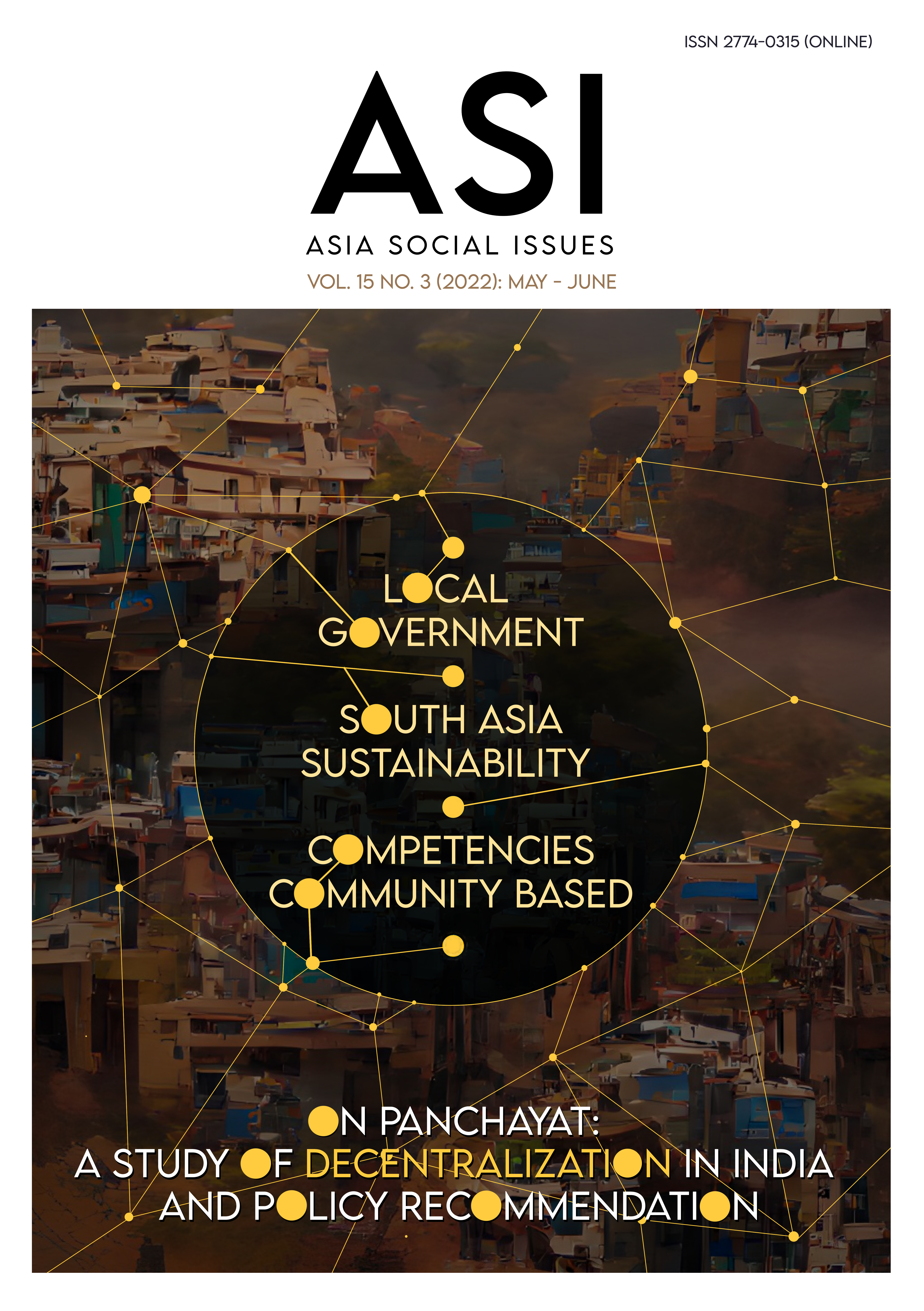The Development of a Self-leadership Model for Students’ Creativity at Universities in Yunnan Province, China
Main Article Content
Abstract
In a knowledge-based economy, creativity is important for maintaining a country’s competitiveness. As the main educational institution that provides fresh blood to the nation’s talent pool, universities need to find appropriate ways to nurture creative minds to enhance the nation’s competitiveness. The purpose of this study was to develop a self-leadership model to increase students’ creativity at universities in Yunnan Province, China. The research methodologies used in this study were literature synthesis, descriptive statistics, regression analysis, focus group discussion, and paired-samples t test. Through such a combination of qualitative and quantitative research, this model was developed with students’ self-leadership skills as the key, with activities for creativity, supervisor leadership and organizational structure as supporting factors for creativity development. After a four-week intervention, the model was proven to be effective in enhancing students’ creativity. The researcher recommends that university administrators in Yunnan Province, China, consider using this model as a means of increasing students’ creativity.
Article Details
Copyright: CC BY-NC-ND 4.0
References
Amabile, T. M. (1983). The social psychology of creativity: A componential conceptualization. Journal of Personality and Social Psychology, 45(2), 357-376.
Amabile, T. M. (2012). Componential theory of creativity. Retrieved from https://www.hbs.edu/ris/Publication%20Files/12-096.pdf
Blanchard, K. (2005). Self-Leadership and one minute manager. New York, United States: Gramedia Pustaka Utama.
Bryant, A., & Kazan, A. L. (2012). Self-leadership: how to become a more successful, efficient, and effective leader from the inside out. New York, United States: McGraw Hill Professional.
Cheung, C. K., Roskams, T., & Fisher, D. (2006). Enhancement of creativity through a one‐semester course in university. The Journal of Creative Behavior, 40(1), 1-25.
Daskal, L. (2017). The leadership gap: What gets between you and your greatness. New York, United States: Penguin.
DiLiello, T. C., & Houghton, J. D. (2006). Maximizing organizational leadership capacity for the future: Toward a model of self‐leadership, innovation, and creativity. Journal of Managerial Psychology, 21(4), 319-337.
Earley, M. A. (2014). A synthesis of the literature on research methods education. Teaching in Higher Education, 19(3), 242-253.
Guilford, J. P. (1967). Creativity: Yesterday, today, and tomorrow. The Journal of Creative Behavior, 1(1), 3-14.
Guilford, J. P. (1973). Characteristics of creativity. Retrieved from https://files.eric.ed.gov/fulltext/ED080171.pdf
Houghton, J. D., & Neck, C. P. (2002). The revised self‐leadership questionnaire: Testing a hierarchical factor structure for self-leadership. Journal of Managerial Psychology, 17(8), 672-691.
Houghton, J. D., & Yoho, S. K. (2005). Toward a contingency model of leadership and psychological empowerment: when should self-leadership be encouraged? Journal of Leadership and Organizational Studies, 11(4), 65-83.
Houghton, J. D., Wu, J., Godwin, J. L., Neck, C. P., & Manz, C. C. (2012). Effective stress management: A model of emotional intelligence, self-leadership, and student stress coping. Journal of Management Education, 36(2), 220-238.
Hulme, E., Thomas, B., & De La Rosby, H. (2014). Developing creativity ecosystems: Preparing college students for tomorrow’s innovation challenge. About Campus, 19(1), 14-23.
Kern, D., Phillips, J., Tewari, J., Jones Jr, K. E., & Edwards, S. (2017). A decade of progress in self-leadership research. Regional Business Review, 36(37), 20-50.
Krejcie, R. V., & Morgan, D. W. (1970). Determining sample size for research activities. Educational and Psychological Measurement, 30(3), 607-610.
Lee, J. (2018). The effects of knowledge sharing on individual creativity in higher education institutions: socio-technical view. Administrative Sciences, 8(2), 1-16.
Mahdi, R., Sukarman, S. S., & Yok, M. C. K. (2015). Fostering creativity through innovation engagement in science and technology education: Case study of Universiti Teknologi MARA students. Procedia-Social and Behavioral Sciences, 167, 256-260.
Manz, C. C. (1986). Self-leadership: Toward an expanded theory of self-influence processes in organizations. Academy of Management Review, 11(3), 585-600.
Marquis, E., Radan, K., & Liu, A. (2017). A present absence: Undergraduate course outlines and the development of student creativity across disciplines. Teaching in Higher Education, 22(2), 222-238.
Marshall, G., Kiffin-Petersen, S., & Soutar, G. (2012). The influence personality and leader behaviors have on teacher self-leadership in vocational colleges. Educational Management Administration and Leadership, 40(6), 707-723.
Maykrantz, S. A., & Houghton, J. D. (2020). Self-leadership and stress among college students: Examining the moderating role of coping skills. Journal of American College Health, 68(1), 89-96.
Morrison, A., & Johnston, B. (2003). Personal creativity for entrepreneurship: Teaching and learning strategies. Active Learning in Higher Education, 4(2), 145-158.
Neck, C. P., & Houghton, J. D. (2006). Two decades of self‐leadership theory and research. Journal of Managerial Psychology, 21(4), 270-295.
Puccio, G. J. (2017). From the dawn of humanity to the 21st century: Creativity as an enduring survival skill. The Journal of Creative Behavior, 51(4), 330-334.
Rabiee, F. (2004). Focus-group interview and data analysis. Proceedings of the Nutrition Society, 63(4), 655-660.
Rovinelli, R. J., & Hambleton, R. K. (1977). On the use of content specialists in the assessment of criterion-referenced test item validity. Dutch Journal of Educational Research, 2, 49-60.
Seechaliao, T. (2017). Instructional strategies to support creativity and innovation in education. Journal of Education and Learning, 6(4), 201-208.
Sternberg, R. J. (2006). The nature of creativity. Creativity Research Journal, 18(1), 87-98.
Stewart, G. L., Courtright, S. H., & Manz, C. C. (2019). Self-leadership: A paradoxical core of organizational behavior. Annual Review of Organizational Psychology and Organizational Behavior, 6, 47-67.
Wood, D., & Bilsborow, C. (2014). “I am not a person with a creative mind”: Facilitating creativity in the undergraduate curriculum through a design-based research approach. Electronic Journal of e-Learning, 12(1), 111-125.
Yeh, Y. C., Yeh, Y. L., & Chen, Y. H. (2012). From knowledge sharing to knowledge creation: A blended knowledge-management model for improving university students’ creativity. Thinking Skills and Creativity, 7(3), 245-257.


